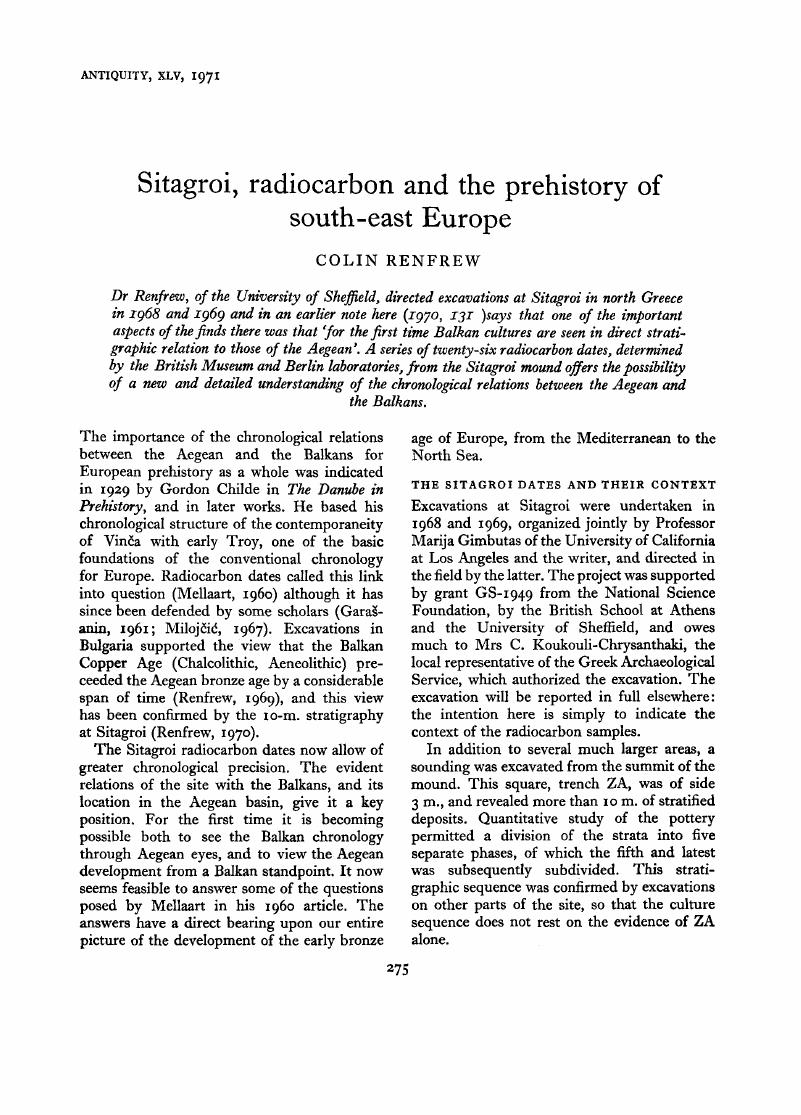Crossref Citations
This article has been cited by the following publications. This list is generated based on data provided by
Crossref.
Whitehouse, Ruth
1972.
The rock-cut tombs of the central Mediterranean.
Antiquity,
Vol. 46,
Issue. 184,
p.
275.
DAVIDSON, D. A.
1973.
PARTICLE SIZE AND PHOSPHATE ANALYSIS‐EVIDENCE FOR THE EVOLUTION OF A TELL.
Archaeometry,
Vol. 15,
Issue. 1,
p.
143.
Hood, Sinclair
1973.
An early oriental cylinder seal impression from Romania?.
World Archaeology,
Vol. 5,
Issue. 2,
p.
187.
Harrison, Richard J.
1974.
Origins of the Bell Beaker cultures.
Antiquity,
Vol. 48,
Issue. 190,
p.
99.
RENFREW, C.
and
CLARK, R. M.
1974.
PROBLEMS OF THE RADIOCARBON CALENDAR AND ITS CALIBRATION.
Archaeometry,
Vol. 16,
Issue. 1,
p.
5.
Whitehouse, Ruth
and
Renfrew, Colin
1974.
The Copper Age of Peninsular Italy and the Aegean.
The Annual of the British School at Athens,
Vol. 69,
Issue. ,
p.
343.
Greig, J.R.A.
and
Turner, J.
1974.
Some pollen diagrams from Greece and their archaeological significance.
Journal of Archaeological Science,
Vol. 1,
Issue. 2,
p.
177.
Turner, Judith
and
Greig, James R.A.
1975.
Some Holocene pollen diagrams from Greece.
Review of Palaeobotany and Palynology,
Vol. 20,
Issue. 3,
p.
171.
Burleigh, Richard
Hewson, Andrew
and
Meeks, Nigel
1977.
British Museum Natural Radiocarbon Measurements IX.
Radiocarbon,
Vol. 19,
Issue. 2,
p.
143.
Renfrew, Colin
1978.
Varna and the social context of early metallurgy.
Antiquity,
Vol. 52,
Issue. 206,
p.
199.
RENFREW, COLIN
and
POSTON, TIM
1979.
Transformations.
p.
437.
Sterud, Eugene L.
1979.
Recent Developments in Old World Archaeology.
American Antiquity,
Vol. 44,
Issue. 4,
p.
692.
Rottländer, Rolf C. A.
1979.
Antike Längenmaße.
p.
112.
Warren, Peter
1980.
Problems of Chronology in Crete and the Aegean in the Third and Earlier Second Millennium B. C..
American Journal of Archaeology,
Vol. 84,
Issue. 4,
p.
487.
Evans, Robert K.
and
Rasson, Judith A.
1984.
Part I: Ex Balcanis Lux? Recent Developments in Neolithic and Chalcolithic Research in Southeast Europe.
American Antiquity,
Vol. 49,
Issue. 4,
p.
713.
Núñez, Diego Rivera
and
Walker, Michael J.
1989.
A review of palaeobotanical findings of early Vitis in the mediterranean and of the origins of cultivated grape-vines, with special reference to new pointers to prehistoric exploitation in the western mediterranean.
Review of Palaeobotany and Palynology,
Vol. 61,
Issue. 3-4,
p.
205.
Willis, K.J.
and
Bennett, K.D.
1994.
The Neolithic transition - fact or fiction? Palaeoecological evidence from the Balkans.
The Holocene,
Vol. 4,
Issue. 3,
p.
326.
Cazzella, Alberto
1994.
Dating the 'Copper Age' in the Italian Peninsula and Adjacent Islands.
Journal of European Archaeology,
Vol. 2,
Issue. 1,
p.
1.
Hertelendi, Ede
Kalicz, Nándor
Raczky, Pál
Horváth, Ferenc
Veres, Mihály
Svingor, Éva
Futó, István
and
Bartosiewicz, László
1995.
Re-Evaluation of the Neolithic in Eastern Hungary Based on Calibrated Radiocarbon Dates.
Radiocarbon,
Vol. 37,
Issue. 2,
p.
239.
Johnson, Mats
1999.
Chronology of Greece and South-east Europe in the Final Neolithic and Early Bronze Age.
Proceedings of the Prehistoric Society,
Vol. 65,
Issue. ,
p.
319.





